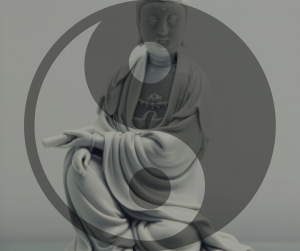What is Yin Yoga?
Posted on March 14 2018,


Increasingly, the phrase “Yin yoga” is floating through the yogi circuit airwaves, slowly getting louder and more insistent. But a lot of people are not clear on what exactly “Yin yoga” means, especially in turbo-paced places like New England, where Kulae is based. So, we decided to do some research and give you the shakedown on the new down dog. Here are the basics:
What does “yin” mean?
First recorded in 1671, the Chinese character 陰 (yin) can mean “shade” or “moon” or “hidden” or even “secret” — with an added rough English definition of the word “lee”. Google defines “yin” as “(in Chinese philosophy) the passive female principle of the universe, characterized as female and sustaining and associated with earth, dark, and cold.” Merriam-Webster Dictionary adds that yin “combines with yang to produce all that comes to be.” So, what does that look like in combination with the word yoga?
What does Yin yoga look like?
The Western practice of Yin yoga is mainly comprised of passive floor postures. Each pose is typically held for between 3 and 15 minutes, though some classes hold for as few as 1 and as many as 20 minutes! The held poses are often likened a form of slow-motion moving meditation; instead of drawing your mind back to just your breath, you anchor your mind with the whole pose. Poses from “yang” yogas like vinyasa and Bikram are often present in yin practice, but are given different names (typically descriptive, nature-themed English words like “caterpillar”) to help mentally separate the activeness of the “yang” poses from the passiveness of their yin counterparts. It goes without saying that some “yang” poses cannot safely be done at yin speed, like many balance- or inversion-based poses where lots of muscle activity is necessarily for bodily safety. That being said, Yin yoga is not restorative yoga; there is extreme challenge in holding a pose for such an exceptional duration, both mentally and physically — especially if patience is not your strongest suit!
Who does Yin yoga?
There are many different people who would benefit greatly from a little Yin yoga in their life. Athletes with tight joints and ligaments, people who love meditation but struggle with sitting still for prolonged periods of time, and fast-moving “yangster” yogis might all benefit greatly from some Yin yoga sessions. Yin yoga is also used as supportive therapy for those combating addiction, mental illness, chronic pain, or any other major life struggle or crisis. Some believe that Yin yoga helps to clear chi/prana pathways in the body, helping to restore internal balance that way. Yin also can help to balance out people with an already very active life or high volumes of “mind chatter” for whom “yang” styles yoga might only exacerbate that state of being.
What does Yin yoga do?
Like other yoga, Yin yoga induces calmness and stress-reduction, as well as improves flexibility, joint mobility, and circulation. Initially developed in part from Taoist practices — remember that “Tao” means “the middle” — Yin yoga prioritizes striving for balance. Therefore, the point of Yin yoga is to bring harmony to the practitioner, either generally in their daily life or specifically through balancing out their “yang” yoga practice. Yin yoga is also used to help regulate the flow of energy in the body through deep tissue work by asking the practitioner to relax fully into each pose to access the deepest tissues of the body. One of the most fundamental differences between Yin yoga and other practices is that holding the poses for several minutes results in a refreshing stretch in specifically the joints instead of the muscles. Much of the physical focus of Yin yoga is on accessing specific joints, like the hips, pelvis, and lower spine, and encouraging flexibility in those spots. Practitioners aim to find stillness in these prolonged poses to cool and calm the body. Yin yoga also cultivates balance by helping yogis find their edge in both body and emotion; this stems from the belief that certain organs and body parts hold different emotions and temperaments. In this way, yin practice can release locked up and stagnant connective tissues as the yogi releases more locked up and suppressed thoughts and feelings. Yin yoga also provides a happy medium between motion and meditation: it gives space for emotions to surface and the head to clear like meditation does without the distraction of perpetual body motion or muscle work of “yang” yoga. And now you’re probably asking: whose idea was this?
Where did Yin yoga come from?
There are three big players in the development of today’s Western practice of Yin yoga. The roots that would grow into this new Yin yoga tree sprouted in the late ’70s, courtesy of a man named Paulie Zink. Zink studied for 10 years under a Monkey Kung Fu master from Hong Kong named Cho Chat Ling. Zink’s unique, blended yoga style, which he referred to as “Taoist Yoga” or “Dai Yin,” was adopted from both Indian and Chinese tradition, specifically from their condition training for sitting in meditation for very extended periods of time. Zink also believed in practicing a combination of kung fu, Yin yoga, “yang” yoga, qigong, meditation, and “Taoist alchemy” — the theory of the five elements in Chinese medicine — in order to promote balance, harmony, and peace within one’s own body and mind. His integrated style of yoga was designed as a bridge in what he saw as the gap in the Western yogi where all things yin were meant to be. In the late ’80s, a man named Paul Grilley saw Zink on TV and became dedicated to meeting and working with Zink. Grilley began to infuse his own yoga practice and teaching style with what he continued to call Taoist yoga, as well as adapting acupunctural techniques and pathways into it. Grilley’s thinking was heavily influenced by the Japanese Dr. Hiroshi Motoyama, whose core research at the time was in the physiology of Chinese medicine. Sarah Powers of Chicago was the next to build upon this new Taoist yoga tradition, adding her knowledge of Buddhist tradition to this special yogic mélange. It was she who suggested that they change the name of their now distinct style of yogic practice to “Yin yoga” in order to differentiate from other forms of Taoist yoga.
What are people saying about Yin yoga?
Last but not least, here are some descriptions of Yin yoga practice from people who love the gifts it has to offer:
“This intimate practice of yoga requires students to be ready to get intimate with the self, with feelings, sensations, and emotions, something of which I have noticed can be easy to avoid in a fast-paced yoga practice.” — Hope Zvara, here
“On a mental and emotional level, the practice allows the body to drop down into the parasympathetic nervous system, and therefore becomes deeply healing and nourishing. Practitioners report that it is grounding, calming and revitalising, with profound energetic and emotional effects…. Yin yoga is a simple, quiet practice, but – make no mistake – it is not always an easy or comfortable one.” — Geraldine Beirne, here
“Meet your own shadow…. We spend a great deal of our life advertising our best self, and, during this campaign, we tend to bury our least flattering traits deep down. We are often ashamed or afraid of this shadow and go to great extents to avoid its tenebrous influence…. As we sometimes sit in the discomfort of a Yin pose, we can observe our shadow under a kind light. In this respect, the practice of Yin Yoga helps unearthing and integrating our dark side without putting up too much of a fight.” — Sophie Legrand, here
That concludes our brief lesson on Yin yoga! Have you ever tried Yin yoga? What’s your favorite part about it? Leave us a comment!

0 comments